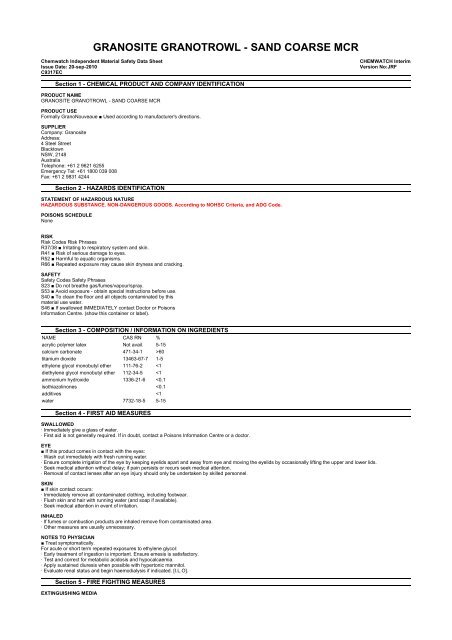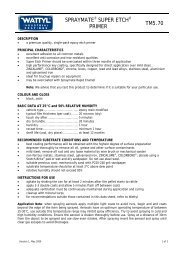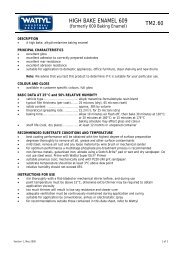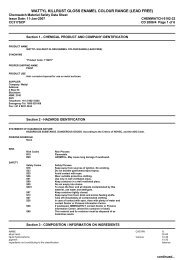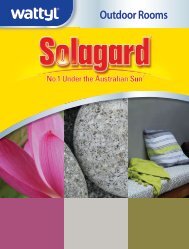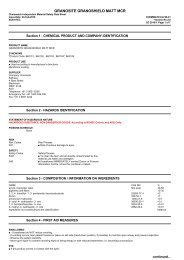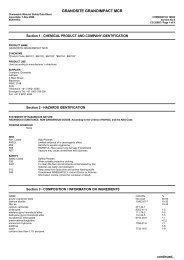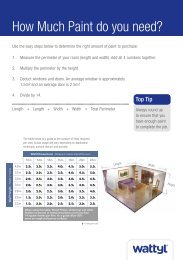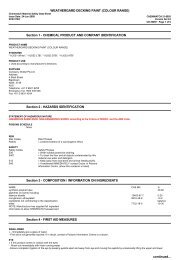MSDS - Wattyl
MSDS - Wattyl
MSDS - Wattyl
Create successful ePaper yourself
Turn your PDF publications into a flip-book with our unique Google optimized e-Paper software.
GRANOSITE GRANOTROWL - SAND COARSE MCRChemwatch Independent Material Safety Data SheetIssue Date: 20-sep-2010C9317ECCHEMWATCH InterimVersion No:JRFSection 1 - CHEMICAL PRODUCT AND COMPANY IDENTIFICATIONPRODUCT NAMEGRANOSITE GRANOTROWL - SAND COARSE MCRPRODUCT USEFormally GranoNouveaue ■ Used according to manufacturer's directions.SUPPLIERCompany: GranositeAddress:4 Steel StreetBlacktownNSW, 2148AustraliaTelephone: +61 2 9621 6255Emergency Tel: +61 1800 039 008Fax: +61 2 9831 4244Section 2 - HAZARDS IDENTIFICATIONSTATEMENT OF HAZARDOUS NATUREHAZARDOUS SUBSTANCE. NON-DANGEROUS GOODS. According to NOHSC Criteria, and ADG Code.POISONS SCHEDULENoneRISKRisk Codes Risk PhrasesR37/38 ■ Irritating to respiratory system and skin.R41 ■ Risk of serious damage to eyes.R52 ■ Harmful to aquatic organisms.R66 ■ Repeated exposure may cause skin dryness and cracking.SAFETYSafety Codes Safety PhrasesS23 ■ Do not breathe gas/fumes/vapour/spray.S53 ■ Avoid exposure - obtain special instructions before use.S40 ■ To clean the floor and all objects contaminated by thismaterial use water.S46 ■ If swallowed IMMEDIATELY contact Doctor or PoisonsInformation Centre. (show this container or label).Section 3 - COMPOSITION / INFORMATION ON INGREDIENTSNAME CAS RN %acrylic polymer latex Not avail. 5-15calcium carbonate 471-34-1 >60titanium dioxide 13463-67-7 1-5ethylene glycol monobutyl ether 111-76-2
· There is no restriction on the type of extinguisher which may be used.· Use extinguishing media suitable for surrounding area.FIRE FIGHTING· Alert Fire Brigade and tell them location and nature of hazard.· Wear breathing apparatus plus protective gloves for fire only.· Prevent, by any means available, spillage from entering drains or water courses.· Use fire fighting procedures suitable for surrounding area.FIRE/EXPLOSION HAZARD· Non combustible.· Not considered a significant fire risk, however containers may burn.Decomposition may produce toxic fumes of:.carbon dioxide (CO2).other pyrolysis products typical of burning organic material.FIRE INCOMPATIBILITY· Avoid contamination with oxidising agents i.e. nitrates, oxidising acids, chlorine bleaches, pool chlorine etc. as ignition may result.HAZCHEMNonePERSONAL PROTECTIONGlasses: Gloves: Respirator:Chemical goggles. PVC chemical resistant type. Type AK Filter of sufficient capacitySection 6 - ACCIDENTAL RELEASE MEASURESMINOR SPILLS· Clean up all spills immediately.· Avoid breathing vapours and contact with skin and eyes.· Control personal contact by using protective equipment.· Contain and absorb spill with sand, earth, inert material or vermiculite.MAJOR SPILLS■ Moderate hazard.· Clear area of personnel and move upwind.· Alert Fire Brigade and tell them location and nature of hazard.· Wear breathing apparatus plus protective gloves.· Prevent, by any means available, spillage from entering drains or water course.Personal Protective Equipment advice is contained in Section 8 of the <strong>MSDS</strong>.Section 7 - HANDLING AND STORAGEPROCEDURE FOR HANDLING· Avoid all personal contact, including inhalation.· Wear protective clothing when risk of exposure occurs.· Use in a well-ventilated area.· Avoid contact with moisture.· DO NOT allow clothing wet with material to stay in contact with skin.SUITABLE CONTAINER· Polyethylene or polypropylene container.· Packing as recommended by manufacturer.· Check all containers are clearly labelled and free from leaks.STORAGE INCOMPATIBILITY· Avoid reaction with oxidising agents.STORAGE REQUIREMENTS· Store in original containers.· Keep containers securely sealed.· Store in a cool, dry, well-ventilated area.· Store away from incompatible materials and foodstuff containers.Section 8 - EXPOSURE CONTROLS / PERSONAL PROTECTIONEXPOSURE CONTROLSSource Material TWA ppm TWA mg/m³ STEL ppm STEL mg/m³ Notes___________ ___________ _______ _______ _______ _______ _______Australia Exposure calcium carbonate10 (see Chapter 14)Standards(Calcium carbonateAustralia ExposureStandardsAustralia ExposureStandards(a))titanium dioxide(Titanium dioxide(a))ethylene glycolmonobutyl ether (2-Butoxyethanol)Australia Exposure ammoniumStandardshydroxide(Ammonia)The following materials had no OELs on our records• diethylene glycol monobutyl ether: CAS:112-34-5• water:CAS:7732-18-510 (see Chapter 14)20 96.9 50 242 Sk25 17 35 24PERSONAL PROTECTIONRESPIRATORType AK Filter of sufficient capacityEYE· Safety glasses with side shields.· Chemical goggles.· Contact lenses may pose a special hazard; soft contact lenses may absorb and concentrate irritants. A written policy document, describing the wearing of lens orrestrictions on use, should be created for each workplace or task. This should include a review of lens absorption and adsorption for the class of chemicals in useand an account of injury experience. Medical and first- aid personnel should be trained in their removal and suitable equipment should be readily available. In theevent of chemical exposure, begin eye irrigation immediately and remove contact lens as soon as practicable. Lens should be removed at the first signs of eye redness
or irritation - lens should be removed in a clean environment only after workers have washed hands thoroughly. [CDC NIOSH Current Intelligence Bulletin 59].HANDS/FEET· Wear chemical protective gloves, eg. PVC.· Wear safety footwear or safety gumboots, eg. Rubber.OTHER· Overalls.· Eyewash unit.ENGINEERING CONTROLS■ None under normal operating conditions.General exhaust is adequate under normal operating conditions. Local exhaust ventilation may be required in specific circumstances.Section 9 - PHYSICAL AND CHEMICAL PROPERTIESAPPEARANCE■ Acrylic polymer emulsions may contain residual traces of odourous acrylic monomers; the amounts remaining in compounded mixtures represents a very low order ofexposure, however this may become noticeable with some materials particularly in confined or poorly ventilated spaces.White or coloured viscous heavy bodied paste with a mild ammoniacal odour.Miscible with water.PHYSICAL PROPERTIESLiquid.Mixes with water.StateMeltingRange(ºC)BoilingRange(ºC)FlashPoint(ºC)DecompositionTemp(ºC)AutoignitionTemp(ºC)UpperExplosiveLimit(%)LowerExplosiveLimit(%)VolatileComponent(%vol)LiquidNotavailable.100NotapplicableNotavailable.NotapplicableNotapplicableNotapplicable10-20MolecularWeightViscositySolubilityinwater(g/L)pH(1%solution)pH(assupplied)VapourPressure(kPa)SpecificGravity(water=1)RelativeVapourDensity(air=1)EvaporationRateNotapplicable.NotAvailableMiscibleNotavailable8-10Notavailable.1.90-2.10>1Notavailableethylene glycol monobutyl ether■ log Kow (Prager 1995): 0.83■ log Kow (Sangster 1997): 0.8Section 10 - CHEMICAL STABILITY AND REACTIVITY INFORMATIONCONDITIONS CONTRIBUTING TO INSTABILITY· Presence of incompatible materials.· Product is considered stable.· Hazardous polymerisation will not occur.For incompatible materials - refer to Section 7 - Handling and Storage.Section 11 - TOXICOLOGICAL INFORMATIONPOTENTIAL HEALTH EFFECTSACUTE HEALTH EFFECTS■ Risk of serious damage to eyes.■ Irritating to respiratory system and skin.CHRONIC HEALTH EFFECTS■ Repeated exposure may cause skin dryness and cracking.TOXICITY AND IRRITATIONETHYLENE GLYCOL MONOBUTYL ETHER:DIETHYLENE GLYCOL MONOBUTYL ETHER:AMMONIUM HYDROXIDE:CALCIUM CARBONATE:■ The material may produce severe irritation to the eye causing pronounced inflammation. Repeated or prolonged exposure to irritants may produce conjunctivitis.AMMONIUM HYDROXIDE:CALCIUM CARBONATE:■ Asthma- like symptoms may continue for months or even years after exposure to the material ceases. This may be due to a non- allergenic condition known as reactiveairways dysfunction syndrome (RADS) which can occur following exposure to high levels of highly irritating compound.TITANIUM DIOXIDE:ETHYLENE GLYCOL MONOBUTYL ETHER:DIETHYLENE GLYCOL MONOBUTYL ETHER:AMMONIUM HYDROXIDE:CALCIUM CARBONATE:■ unless otherwise specified data extracted from RTECS - Register of Toxic Effects of Chemical Substances.ETHYLENE GLYCOL MONOBUTYL ETHER:TITANIUM DIOXIDE:■ The material may cause skin irritation after prolonged or repeated exposure and may produce a contact dermatitis (nonallergic). This form of dermatitis is oftencharacterised by skin redness (erythema) and swelling epidermis.■ Not available. Refer to individual constituents.ACRYLIC POLYMER LATEX:TOXICITYIRRITATIONOral (rat) LD50: >5000 mg/kg [Manfr.RH]■ Acrylic polymer emulsions may contain residual traces of odourous acrylic monomers; the amounts remaining in compounded mixtures represents a very low order of
exposure, however this may become noticeable with some materials particularly in confined or poorly ventilated spaces.CALCIUM CARBONATE:TOXICITYIRRITATIONOral (Rat) LD50: 6450 mg/kgSkin (rabbit): 500 mg/24h-ModerateEye (rabbit): 0.75 mg/24h - SEVERE■ The material may cause skin irritation after prolonged or repeated exposure and may produce a contact dermatitis (nonallergic). This form of dermatitis is oftencharacterised by skin redness (erythema) and swelling the epidermis.No evidence of carcinogenic properties. No evidence of mutagenic orteratogenic effects.TITANIUM DIOXIDE:TOXICITYIRRITATIONOral (Rat) LD50: >20000 mg/kg * Skin (human): 0.3 mg /3D (int)-Mild *Oral (Mouse) LD50: >10000 mg/kg *■ The material may produce moderate eye irritation leading to inflammation. Repeated or prolonged exposure to irritants may produce conjunctivitis.For titanium dioxide:Humans can be exposed to titanium dioxide via inhalation, ingestion or dermal contact. In human lungs, the clearance kinetics of titanium dioxide is poorlycharacterized relative to that in experimental animals.* IUCLIDETHYLENE GLYCOL MONOBUTYL ETHER:TOXICITYIRRITATIONOral (rat) LD50: 470 mg/kgSkin (rabbit): 500 mg, open; MildDermal (rabbit) LD50: 220 mg/kgEye (rabbit): 100 mg/24h-ModerateInhalation (human) TCLo: 100 ppmEye (rabbit): 100 mg SEVEREInhalation (human) TCLo: 195 ppm/8h * [Union Carbide]Inhalation (Rat) LC50: 450 ppm *■ For ethylene glycol:Ethylene glycol is quickly and extensively absorbed through the gastrointestinal tract. Limited information suggests that it is also absorbed through the respiratorytract; dermal absorption is apparently slow.For ethylene glycol monoalkyl ethers and their acetates (EGMAEs):Typical members of this category are ethylene glycol propylene ether (EGPE), ethylene glycol butyl ether (EGBE) and ethylene glycol hexyl ether (EGHE) and theiracetates.EGMAEs are substrates for alcohol dehydrogenase isozyme ADH- 3, which catalyzes the conversion of their terminal alcohols to aldehydes (which are transientmetabolites).Acute Toxicity: Oral LD50 values in rats for all category members range from 739 (EGHE) to 3089 mg/kg bw (EGPE), with values increasing with decreasing molecularweight.Exposure of pregnant rats to ethylene glycol monobutyl ether (2- butoxyethanol) at 100 ppm or rabbits at 200 ppm during organogenesis resulted in maternal toxicityand embryotoxicity including a decreased number of viable implantations per litter. Slight foetoxicity in the form of poorly ossified or unossified skeletal elementswas also apparent in rats.At least one researcher has stated that the reproductive effects were less than that of other monoalkyl ethers of ethylene glycol.NOTE: Changes in kidney, liver, spleen and lungs are observed in animals exposed to high concentrations of this substance by all routes.DIETHYLENE GLYCOL MONOBUTYL ETHER:TOXICITYIRRITATIONOral (rat) LD50: 5660 mg/kgEye (rabbit): 5 mg - SEVEREDermal (rabbit) LD50: 4120 mg/kgEye (rabbit): 20 mg/24h Moderate■ For diethylene glycol monoalkyl ethers and their acetates:This category includes diethylene glycol ethyl ether (DGEE), diethylene glycol propyl ether (DGPE) diethylene glycol butyl ether (DGBE) and diethylene glycol hexylether (DGHE) and their acetates.Acute toxicity: There are adequate oral, inhalation and/or dermal toxicity studies on the category members.AMMONIUM HYDROXIDE:TOXICITYIRRITATIONOral (rat) LD50: 350 mg/kgEye (rabbit): 0.25 mg SEVEREOral (human) LDLo: 43 mg/kgEye (rabbit): 1 mg/30s SEVEREInhalation (human) LCLo: 5000 ppm/5mInhalation (human) TCLo: 20 ppmInhalation (rat) LC50: 2000 ppm/4hUnreported (man) LDLo: 132 mg/kgWATER:■ No significant acute toxicological data identified in literature search.CARCINOGENTitaniumdioxide2-ButoxyethanolInternationalAgencyforResearchonCancer(IARC)-AgentsReviewedby theIARCMonographsInternationalAgencyforResearchonCancer(IARC)-AgentsReviewedby theIARCMonographsGroupGroup 32BSKINethyleneglycolmonobutyletherND Notes SkSection 12 - ECOLOGICAL INFORMATIONHarmful to aquatic organisms.EcotoxicityIngredientPersistence:Water/SoilPersistence:AirBioaccumulationMobility
titaniumdioxideHIGH LOW HIGHethyleneglycolmonobutylLOW LOW LOW HIGHetherdiethyleneglycolmonobutylLOW LOW HIGHetherammoniumhydroxideLOW LOW HIGHwater LOW LOW HIGHSection 13 - DISPOSAL CONSIDERATIONS· Recycle wherever possible.· Consult manufacturer for recycling options or consult local or regional waste management authority for disposal if no suitable treatment or disposal facility can beidentified.· Dispose of by: burial in a land-fill specifically licenced to accept chemical and / or pharmaceutical wastes or incineration in a licenced apparatus (after admixture withsuitable combustible material).· Decontaminate empty containers. Observe all label safeguards until containers are cleaned and destroyed.· Containers may still present a chemical hazard/ danger when empty.· Return to supplier for reuse/ recycling if possible.Otherwise:· If container can not be cleaned sufficiently well to ensure that residuals do not remain or if the container cannot be used to store the same product, then puncturecontainers, to prevent re-use, and bury at an authorised landfill.· Where possible retain label warnings and <strong>MSDS</strong> and observe all notices pertaining to the product.Section 14 - TRANSPORTATION INFORMATIONHAZCHEM:None (ADG7)NOT REGULATED FOR TRANSPORT OF DANGEROUS GOODS: ADG7, UN, IATA, IMDGSection 15 - REGULATORY INFORMATIONPOISONS SCHEDULENoneREGULATIONSRegulations for ingredientscalcium carbonate (CAS: 471-34-1,13397-26-7,15634-14-7,1317-65-3) is found on the following regulatory lists;"Australia High Volume Industrial Chemical List (HVICL)","Australia Inventory of Chemical Substances (AICS)","Australia Therapeutic Goods Administration (TGA)Substances that may be used as active ingredients in Listed medicines","CODEX General Standard for Food Additives (GSFA) - Additives Permitted for Use in Food inGeneral, Unless Otherwise Specified, in Accordance with GMP","GESAMP/EHS Composite List - GESAMP Hazard Profiles","IMO IBC Code Chapter 17: Summary ofminimum requirements","International Council of Chemical Associations (ICCA) - High Production Volume List","OECD Representative List of High Production Volume(HPV) Chemicals"titanium dioxide (CAS: 13463-67-7,1317-70-0,1317-80-2,12188-41-9,1309-63-3,100292-32-8,101239-53-6,116788-85-3,12000-59-8,12701-76-7,12767-65-6,12789-63-8,1344-29-2,185323-71-1,185828-91-5,188357-76-8,188357-79-1,195740-11-5,221548-98-7,224963-00-2,246178-32-5,252962-41-7,37230-92-5,37230-94-7,37230-95-8,37230-96-9,39320-58-6,39360-64-0,39379-02-7,416845-43-7,494848-07-6,494848-23-6,494851-77-3,494851-98-8,55068-84-3,55068-85-4,552316-51-5,62338-64-1,767341-00-4,97929-50-5,98084-96-9) is found on the following regulatory lists;"Australia Exposure Standards","Australia High Volume Industrial Chemical List (HVICL)","Australia Inventory of Chemical Substances (AICS)","Australia TherapeuticGoods Administration (TGA) Substances that may be used as active ingredients in Listed medicines","Australia Therapeutic Goods Administration (TGA) Sunscreeningagents permitted as active ingredients in listed products","CODEX General Standard for Food Additives (GSFA) - Additives Permitted for Use in Food in General, UnlessOtherwise Specified, in Accordance with GMP","GESAMP/EHS Composite List - GESAMP Hazard Profiles","IMO IBC Code Chapter 17: Summary of minimumrequirements","International Agency for Research on Cancer (IARC) - Agents Reviewed by the IARC Monographs","OECD Representative List of High ProductionVolume (HPV) Chemicals"ethylene glycol monobutyl ether (CAS: 111-76-2) is found on the following regulatory lists;"Australia Exposure Standards","Australia Hazardous Substances","Australia High Volume Industrial Chemical List (HVICL)","Australia Inventory of Chemical Substances(AICS)","IMO MARPOL 73/78 (Annex II) - List of Other Liquid Substances","International Agency for Research on Cancer (IARC) - Agents Reviewed by the IARCMonographs","OECD Representative List of High Production Volume (HPV) Chemicals"diethylene glycol monobutyl ether (CAS: 112-34-5) is found on the following regulatory lists;"Australia Hazardous Substances","Australia High Volume Industrial Chemical List (HVICL)","Australia Inventory of Chemical Substances (AICS)","Australia Standard forthe Uniform Scheduling of Drugs and Poisons (SUSDP) - Schedule 5","IMO MARPOL 73/78 (Annex II) - List of Other Liquid Substances","OECD Representative List ofHigh Production Volume (HPV) Chemicals"ammonium hydroxide (CAS: 1336-21-6) is found on the following regulatory lists;"Australia Hazardous Substances","Australia Inventory of Chemical Substances (AICS)","Australia Standard for the Uniform Scheduling of Drugs and Poisons (SUSDP) -Appendix F (Part 3)","CODEX General Standard for Food Additives (GSFA) - Additives Permitted for Use in Food in General, Unless Otherwise Specified, in Accordancewith GMP","IMO MARPOL 73/78 (Annex II) - List of Noxious Liquid Substances Carried in Bulk","International Council of Chemical Associations (ICCA) - High ProductionVolume List","OECD Representative List of High Production Volume (HPV) Chemicals"water (CAS: 7732-18-5) is found on the following regulatory lists;"Australia Inventory of Chemical Substances (AICS)","IMO IBC Code Chapter 18: List of products to which the Code does not apply","OECD Representative List of HighProduction Volume (HPV) Chemicals"No data for Granosite GRANOTROWL - SAND COARSE MCR (CW: 8064-03)No data for acrylic polymer latex (CAS: , Not avail)Section 16 - OTHER INFORMATIONINGREDIENTS WITH MULTIPLE CAS NUMBERSIngredientNameCAScalciumcarbonate471-34-1, 13397-26-7, 15634-14-7, 1317-65-3titaniumdioxide13463-67-7, 1317-70-0, 1317-80-2, 12188-41-9, 1309-63-3, 100292-32-8, 101239-53-6, 116788-85-3, 12000-59-8, 12701-76-7, 12767-65-6, 12789-63-8, 1344-29-2, 185323-71-1, 185828-91-5, 188357-76-8, 188357-79-1, 195740-11-5, 221548-98-7, 224963-00-2, 246178-32-5, 252962-41-7,37230-92-5, 37230-94-7, 37230-95-8, 37230-96-9, 39320-58-6, 39360-64-0, 39379-02-7, 416845-43-7, 494848-07-6, 494848-23-6, 494851-77-3,494851-98-8, 55068-84-3, 55068-85-4, 552316-51-5, 62338-64-1, 767341-00-4, 97929-50-5, 98084-96-9■ Classification of the preparation and its individual components has drawn on official and authoritative sources as well as independent review by the ChemwatchClassification committee using available literature references.A list of reference resources used to assist the committee may be found at:www.chemwatch.net/references.
■ The (M)SDS is a Hazard Communication tool and should be used to assist in the Risk Assessment. Many factors determine whether the reported Hazards are Risks inthe workplace or other settings.This document is copyright. Apart from any fair dealing for the purposes of private study, research, review orcriticism, as permitted under the Copyright Act, no part may be reproduced by any process without writtenpermission from CHEMWATCH. TEL (+61 3) 9572 4700.Issue Date: 20-Sep-2010Print Date: 20-Sep-2010This is the end of the <strong>MSDS</strong>.


